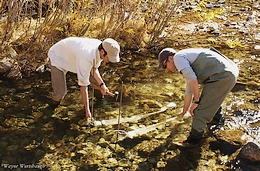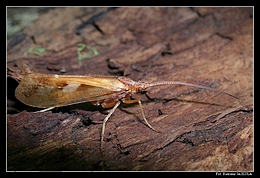 It doesn’t take a Ph.D to notice it’s easier to fish and wade downstream versus fighting the current or moving upstream. Despite our best efforts, fishing upstream is mostly slack management, the line’s pouring towards you at the speed of the current and you’re doing you’re best to keep some small connection with the fly.
It doesn’t take a Ph.D to notice it’s easier to fish and wade downstream versus fighting the current or moving upstream. Despite our best efforts, fishing upstream is mostly slack management, the line’s pouring towards you at the speed of the current and you’re doing you’re best to keep some small connection with the fly.
If we struggle with two legs, wouldn’t the same be true of critters with six?
Organic drift is an entomological term describing the tendency of aquatic insects to move downstream. Despite their clinging, crawling, burrowing, behavior – once they’re exposed to the current, they’ve all the same issues we do.
In a widely cited paper, Muller (1954) noted an apparent paradox in the downstream movements of insects, suggesting that with the large numbers drifting downstream, one would expect to see a depopulation of upstream reaches. However, this was never observed. He proposed that upstream flights of adult aquatic insects compensated for the downstream movements of the larval forms, thus resolving the apparent paradox. Waters (1972) proposed the ‘excess production hypothesis’, which
suggested that the production of insect progeny was in excess of the stream’s carrying capacity, compensating for the drift (i.e. these drifting insects are ‘extras’). The true explanation is probably a combination of both colonization hypothesis and the excess production hypothesis, and perhaps some other factors. Researchers continue to look for answers (e.g. Hershey et. al. 1993).
Mother Nature knows humans and insects are prone to fits of laziness, and she’s lent considerable help by making the egg laying phase of aquatic insects the winged form. Prevailing theory suggest that adults have a tendency to fly upstream to ensure eggs and nymphs are redistributed throughout the watershed.
 To us lay scientists it makes perfect sense, at the point the female daubs the water surface with an egg packet, the current assists the eggs to find purchase downstream of the point of impact.
To us lay scientists it makes perfect sense, at the point the female daubs the water surface with an egg packet, the current assists the eggs to find purchase downstream of the point of impact.
Proving the theory via research has been largely unsuccessful, but there’s a lot of really useful information that could explain fishing phenomenon we’ve witnessed.
A 1964 study of the river Yarty, a chalkstream near Devon, England, suggests areas of bank and stream erosion releases more insects into the water column than solid substrate.
It was found that the more abundant species of the bottom fauna were likewise the most abundant in the drift, with the exception of some common benthic organisms which live in more sheltered niches or have a strong means of attachment.
Anglers are notoriously poor with numbers, but even we know which insects hatch day after day for the bulk of the season. While the time of emergence will change due to seasonal changes in water temperatures and available light, it’s safe to assume a prowling fish will see more of these abundant bugs than anything else.
This verifies some of our “prospecting” theories, if the Blue Wing Olive is the main course – prospecting through the doldrums with no visible fish activity might be best served with … a Blue Wing Olive imitation.
A 1986 study of the Consumnes River in California suggests long pools absorb drifting insects, and unless the pool itself is replenishing the insects, there’s more to eat at the head of a pool that at its tail.
These findings lead us to hypothesize that long pools act as barriers, not filters, to stream macro-invertebrate drift. The composition of drift leaving the pools in this experiment appeared to be controlled by the composition of the benthic habitat at the tail of the pool and not by the composition of upstream drift entering the pools.
Insect drift may also be one of the causes of the “complex” hatch, as many insects (especially midges) will drift en masse during low light or nightfall. Many reasons account for drift, but the low light surge is thought to be a response to visual predators like trout, where the low light increases the chance of survival.
We’ve seen nymphing trout during the evening hatch numerous times, and while emerging insects are present, it’s possible they’re dining on a smorgasbord rather than the hatching insects we can see.
A study in Otsego County, New York, counted drifting caddis over two evenings and found evidence that moonlight depresses the number of caddis in the water column, and of the 152 caught all were members of Caddis families that construct hard cases.
Makes an interesting twist on the theories espoused by practitioners of Czech nymphing – whose imitations are all worm-outside-the-case style.
 Many of these studies show that Midges and Mayflies comprise the bulk of drifting insects, and Stoneflies and Caddis are relatively small in number. This is consistent with what we know of insect behavior, as both midges and mayflies have entire species that are free swimming.
Many of these studies show that Midges and Mayflies comprise the bulk of drifting insects, and Stoneflies and Caddis are relatively small in number. This is consistent with what we know of insect behavior, as both midges and mayflies have entire species that are free swimming.
More drifting insects are available in Spring and Summer, correlating studies suggesting increases in water temperature and volume causes a proportional spike in insect numbers.
The obvious question is, if the insects are in part tumbling about looking for the safety of reattachment – and part intentional drift (overpopulation, predation, hostile environment) – what happens when they have a chance to grab bottom again?
Drifting organisms apparently seek actively their places of protection again in the bottom substrates in response to increasing light intensity in the morning, since drift rates decrease sharply at this time (Waters 1962).
One study suggested that all three (mayflies, caddis, and stoneflies) have a tendency to remain drifting at night even with reattachment possible. The species of mayfly observed only sought attachment during daylight, and the caddis only landed on similar fauna – suggesting there’s some type of preference at work.
Studies on how far insects will drift suggest that 50-60 meters per night is not uncommon. The speed and volume of water movement roughly dictates distance.
As drift levels are not uniform – and one section of creek can contain more bugs mid column than another, it’s left to us lay scientists to correlate all the information into a place to stand shivering.
I’ll take failing sunlight on an eroding bank, upstream of a pool, close to dark, on a waning moon. The rest of the creek we’ll leave to the dry fly fishermen who’re fighting over our scraps in the flat water below.

You’re starting to sound like a blueliner! Do you have a trout fishing trip coming up?
I wanted to find out what bugs do when confronted with a sediment laden chocolate mess – which describes everything near me at the moment.
Bug scientists describe it as “catastrophic drift” where everything sees the encroaching tons of gravel and says, “I’m outta here.”
It’s the same thing that happens when my brownline waders contact blue water, enforced migration.
I’ve seen how trout react to cloudy water when they had the choice to rest in clear water: A dam was being drawn down for maintenance. As the reservoir emptied, the reservoir’s sediment turned the river below into a mess never seen before on that stretch. The fish all moved into clearer water that came from a feeder stream, they were really stacked up. Never seen that since. That was nearly 20 years ago on the Henry’s Fork, and the river hasn’t been the same since.
entomology? I thought trash fish literally ate trash. How else does that carp get fat? Bugs? I though it was from a half dozen gas station burritos?
Jeff: What you describe makes perfect sense, I figured fish sought whatever “shelter” they could, the bug side interests me as well .. being less mobile.
JPL: Carp get their bulk from the wrappers of gas station burritos, WE get our bulk from the contents of same…
Thanks for the excellent overview. Are you aware of any literature on the effects of vegetation patches (e.g. American Water Willow, Justicia americana) on organic drift? I would guess that they would, like pools, serve as drift sinks (and maybe sources). They would present some great feeding opportunities for fish who could reduce energy expenditures by being in these low drag environments, while at the same time getting a ready supply of bugs.
@VSinclair – not specific literature describing vegetative preferences, but some of the documents mentioned a preference for certain types of bottom vegetation. Caddis and mayflies were both mentioned as seeking specific types of bottom substrate.
I’d guess any vegetation extending into the water would gather bugs – even accidentally, it would slow the current much like a rock allowing insects to settle just downstream as well.
Pingback: Dissolved oxygen responsible for aquatic upheaval | Singlebarbed